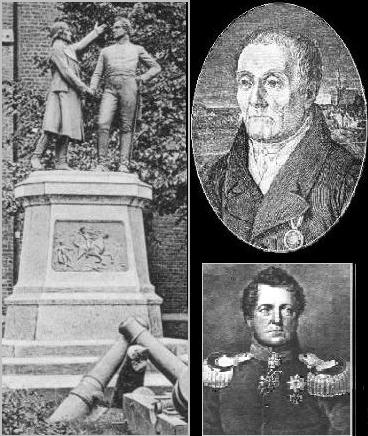
At the end of the war, Nettelbeck commanded his own ship out of Königsberg and plied the Baltic Sea, but for economic reasons, he had to abandon his occupation in 1769. However, he had acquired such a good reputation as a sailor that he was made a Royal Prussian Captain in Stettin in 1770. He then moved back to Kolberg and unsuccessfully tried his hand at business on land.
In 1777, Nettelbeck returned to the sea as a captain of his own ship again, this time prospering, and even though the ship was lost in a violent shipwreck in 1783, he had become a wealthy man. Despite his penchant for controversy and two divorces, he was a well-respected citizen. He later became a royal instructor of nautical education and he also took on his father’s profession as a brewer. He entered local politics and was elected to several offices in Koberg.
After Prussia lost the Battle of Jena-Auerstedt in late 1806, Napoleonic forces marched north into Pomerania and soon occupied Stettin after it surrendered. When fortified Kolberg resisted, the French laid siege in March of 1807. The Kolberg burghers actively participated in a militia created and led by “Citizen’s Adjutant” Nettelbeck and resisted the French. In late April, Prussian Major August von Gneisenau was sent to Kolberg to assist Nettelbeck and he saw to it that the home troops in the town were supplied via Kolberg’s port. The fortress of Kolberg was successfully defended. For this, Gneisenau received medals and a promotion to lieutenant-colonel. The unsuccessful siege was lifted only when Prussia surrendered to Bonaparte in the Peace of Tilsit on July 2.

A monument sculpted by Georg Meyer-Steglitz in 1904 shows Prussian Field marshall August Neidhardt von Gneisenau congratulating Joachim Nettelbeck for defending the town against the troops of Napoleon Bonaparte. “Georg Meyer-Steglitz” (George Renatus Meyer), the talented sculptor of this monument, was the brother of the sculptor Martin Meyer-Pyritz (Martin Meyer). He first studied in Berlin and then in Paris where he rented a studio in Steglitz and henceforth identified himself Georg Meyer-Steglitz. He was well-employed and very productive, although tragically only a few of his magnificent works survive because they were primarily in places in the former Prussian provinces of Posen, Pomerania and Neumark and were willfully destroyed after the second world war along with other evidence of a German regional history. Still other work, mostly very old war memorials, were destroyed by the Allies during the “re-education” of Germany.
There was no Nettelbeck to save Pomerania after the second world war when the town of Kolberg and its centuries of German culture and history were blown to pieces by Allied bombs then given away to communist Poland per the Potsdam Agreement. Kolberg was renamed “Kołobrzeg” and the German population was murdered or forcefully expelled, their homes, money, properties and businesses stolen.